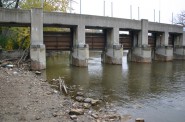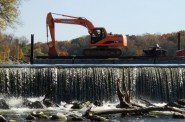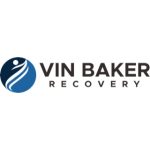The Path Forward for Estabrook Dam
It’s a golden opportunity for Milwaukee if we tone down the rhetoric and consider the potential.
Estabrook Dam Repair Could Complement Milwaukee Water Cluster
The public television documentary “Milwaukee: A City Built on Water” helps explain and illustrate the historical and enduring importance of the Milwaukee River, Lake Michigan and other water resources in this city’s development as we move forward with various water initiatives. In researching Estabrook Dam’s history, one of the most surprising findings for me were parallels between the recent water initiatives (that have transformed Milwaukee’s riverfront areas, and led to establishing the School of Freshwater Sciences and the Global Water Center), and the flood mitigation and park improvement projects completed in the 1920s and ‘30s which included construction of the dam. Consider these similarities:
- Collaboration has been a key attribute of the current water initiatives. Likewise, the projects completed in the 1920s-’30s were the result of more than a decade of collaboration between the City of Milwaukee, Milwaukee County, and a host of federal agencies, to design and construct projects that not only reduced flooding but significantly enhanced recreational uses of the Milwaukee River.
- Whereas the current water initiatives are motivated in part by an ambitious goal — to establish Milwaukee as a global leader in water technology, research, and innovation, the projects in the 1920s-30s were inspired by a similarly lofty goal – to provide high-quality amenities for swimming, boating, and ice skating in Lincoln Park that would be unmatched by any other U.S. city.
- Collaborations involving universities are a key component of today’s water initiatives and the 1920s-‘30s project, where the city and county collaborated with the hydraulics lab at UW-Madison to develop an innovative serpentine design for the spillway that combined beauty (a resemblance to a natural waterfall) with improved functionality (a greatly increased hydraulic capacity). The spillway design is an early Milwaukee water innovation.
- While many recent projects have focused on creating more naturalized habitat suitable for wildlife within the lower reaches of the Milwaukee River lying upstream from the estuary, the earlier projects included creation of a wildlife refuge on islands within Lincoln Park (a first for Milwaukee County?).
- Whereas community based organizations are playing key roles in Milwaukee’s current water initiatives, the Lincoln Park Advancement Commission played a key role in the earlier projects – by lobbying for changes in state law related to flood control projects, and submitting the first petition for flood relief under the new law.
- Whereas over $5 billion has been spent in recent decades for water quality improvements intended in part to help make the Milwaukee River more swimmable, the earlier projects shared the goal of making the Milwaukee River more swimmable, and achieved this through construction of public swimming beaches and support facilities at Lincoln and Estabrook parks that for a period were used by several hundred thousand residents per year.
- While the success of the current water initiative is partly dependent on leveraging scarce federal and state funding, the earlier projects were accomplished in the midst of the Great Depression through the strategic leveraging of the Civilian Conservation Corps and other federal, state, and local public works programs.

Estabrook Park Beach in 1937. It was located directly opposite the Blue Hole – a 15 acre quarry lake connected to the river that was used as a landfill by the City of Milwaukee beginning in the 1950s — a decision that, along with increasing water quality issues, ended use of this beach.
While the significance of these historic similarities to the current controversy is subject to debate, there is a human tendency to underestimate the achievements (and technical sophistication) of earlier generations. Swimmable rivers is still an unachieved goal for Milwaukee’s current water initiatives, whereas the projects completed in the 1920s and 1930s along the Milwaukee River (shown in the above photo) included construction of swimming beaches at both Lincoln and Estabrook Park, which were enjoyed by several hundred thousand residents per year during a brief “golden era” for swimming on the Milwaukee River. The Estabrook Dam should at least be considered in the context of Milwaukee’s history of water innovation, and the goal of a more naturalized river weighed against the achievements of these earlier projects – which mitigated flooding, enhanced recreational uses, preserved the drainage lake, while respecting the rights and concerns of property owners.
The current challenges associated with the dam appear well suited to innovations in systems to guard against power failure, to improve automation of the gates and to provide “real-time” control in response to rapidly changing flow conditions during a storm event, and to design a fish passage that could enhance recreational opportunities as well as reduce upstream flood levels. The possibility for this type of innovation to occur here seems even more plausible given Milwaukee’s status as a leading global center for industrial controls (Rockwell Automation), advanced batteries (Johnson Controls), emergency power systems (Generac and Kohler Power Systems), and use of real-time control systems for managing the flow of stormwater (work by the Milwaukee sewerage district). Estabrook Dam could provide a golden opportunity to demonstrate Milwaukee’s water-related innovations related to designing engineered systems to alleviate flooding while minimizing negative environmental impacts.
The Path Forward
Perhaps the most important factor to weigh in evaluating repair versus removal is that a decision to remove the dam will be permanent. Due to the regulatory challenges with trying to permit any new dam in Wisconsin, building a replacement dam at some future date would likely be impossible. The option to remove the dam after its repair will always be a possibility, and the decision could be made at some future date once there are better data available to document the negative environmental impact of the repaired dam (if any), the flood impacts (if any), and the preferences of residents in neighborhoods that should be included in any future evaluation process.
Overall, the greatest challenge for this section of the Milwaukee River over the past eight years was completing the sediment removal project, which was an overwhelming accomplishment. Repair of the dam is a far smaller, less costly, less technically challenging project. It’s unfortunate that the acrimonious process and all-or-nothing legal battle has made it nearly impossible for any discussions to take place on how to most effectively implement the dam’s repair while moving forward with a host of other improvements and/or opportunities for collaboration. If the adversarial process was replaced by a collaborative process that included repair of the dam, this alternative path forward might include:
- Application of new technological innovations to the challenges posed by dam automation that would reflect Milwaukee’s continued global leadership in industrial control systems, advanced battery technology, and emergency backup power systems.
- Carrying forward with plans initially put forward in the 1920s to transform the south bank of the river opposite Estabrook Park into a publicly accessible green space and environmental corridor. These plans were derailed in the 1950s by the City of Milwaukee’s decision to fill the 15-acre “Blue Hole” lake with municipal waste, and later by UW-Milwaukee’s needs beginning in the mid-1970s for the area to serve as a remote parking lot for commuters, as this story notes. The Blue Hole site and other underutilized areas along the south bank of the Milwaukee River across from Estabrook Park were identified as an environmental corridor in plans developed by SEWRPC more than four decades ago, and the eventual inclusion of the site in the park system was acknowledged by the city when it voted in 1955 to fill the site.
- Design and construction of an updated fish passage at the Estabrook Dam that not only improves access for fish and other aquatic organisms, but which also provides passage for canoes and kayaks, and incorporates an increased weir-length to further mitigate upstream flooding. And while we’re at it, let’s add fish and kayak passages at the Kletzsch Park Dam and the Rock Ledge Falls to create a river that is fish passable and kayak passable from the Mequon-Thiensville Dam to Lake Michigan.
- A potential collaboration by Milwaukee County with the Milwaukee sewerage district, applying the latter’s expertise in using real-time control technologies in the combined sewer and deep tunnel systems, to improving operation and adjustment of the gates of the dam in response to changes in surface water flow during storm events.
- Installation of one or more flood gages within the dam impoundment area to provide real-time flood level data within the impoundment that could be used to improve operation of the gates in response to flooding, as well as to provide data that could be used to further calibrate and refine the flood model for this section of the river.
- An expanded outreach process that once again leverages the involvement of the Lincoln Park neighborhood, only now to help fulfill the vision of the Milwaukee Water Commons in broadening Milwaukee’s water initiatives to include participation by residents of all income levels and backgrounds.
- Construction (once water quality measures are achieved) of a new public swimming beach at Lincoln Park that will help achieve the multi-decades goal of making the Milwaukee River once again a “swimmable river.”
- Construction of new boat launches and rental facilities that will make the impoundment a boat-able water amenity accessible to all.
- New collaborations with local universities to provide enhanced monitoring of water quality, flow, and ecological conditions in this section of the Milwaukee River to advance the science relevant to solving the continuing global challenge of balancing the needs of the human and natural communities in use and control of river systems.
- Renewed efforts to restore funding for researchers within the WDNR. According to its research, the Estabrook Dam is only one of approximately 3,900 dams (and 1,160 large dams) that exist in Wisconsin and for which additional research on the economic and environmental impacts of removal vs repair would be of use in future decisions. The decision over the fate of this single dam has generated significant interest and concern by thousands of area residents (and voters), and could have tens of millions of dollars in economic impacts.
The alternative path forward is removal of the dam. This will almost certainly lead to a series of lawsuits by property owners, and a continuation of the acrimonious relationship between environmental groups and property owners bordering the river. If a significant decrease in property values is proven to occur as a result of the dam’s removal, this will impact the long-term credibility of groups advocating for removal. More “bad news” will likely be reported on a regular basis, as other costs associated with removal become more apparent. For the Woolen Mills Dam in West Bend, the initial removal cost of $82,000 proved to be accurate, but ended up being less than 4 percent of a total of $2.3 million ultimately spent on improvements and restoration within the 61-acre former impoundment area.
All of which convinces me the decision whether to remove or repair the Estabrook Dam is hugely important to the future of this metro area. The issue deserves a full discussion of all the potential costs and benefits and collaborative opportunities of either decision.
David Holmes is a Milwaukee-based environmental scientist and urban revitalization consultant, currently pursuing a Doctorate in Freshwater Sciences at the UW-Milwaukee School of Freshwater Science.
Article Continues - Pages: 1 2
A Freshwater Controversy
-
Estabrook Dam’s Environmental Impact
![Photograph of fish passing through the fish passage at the Mequon-Thiensville Dam. As of June 2015, a total of 35-species of fish have been recorded by a “fishcam” in the act of swimming past the dam [http://www.co.ozaukee.wi.us/1248/Fishway-Camera]).](https://urbanmilwaukee.com/wp-content/uploads/2016/01/image03-185x122.jpg) Jan 17th, 2016 by David Holmes
Jan 17th, 2016 by David Holmes
-
Does the Estabrook Dam Cause Flooding?
 Dec 30th, 2015 by David Holmes
Dec 30th, 2015 by David Holmes
-
Repairing Estabrook Dam Will Cost Less
 Dec 23rd, 2015 by David Holmes
Dec 23rd, 2015 by David Holmes





















Kudos to David Holmes for trying to dissect this complex issue and analyze reams of data, scientific and fiscal issues, etc. I hope his goal of productive dialog and innovative thinking about this might be achieved.
Wonderful summarization to this contentious issue. Simply stated, easily understood…the goal should and must be a win win resolution. All of us must come out winners. Not one side or the other. Continue the dialogue with the community. Not special interest groups.
It is unfortunate how easy it has been for the pro-removal group to overly simplify the topic and control the discussion. Ever since I paddled the Milwuakee river for the first time a few years ago I knew the “lake” created by the dam could be a real asset if cleaned up. I hate that people are making up their minds on this topic simply based on the information put out there by the Riverkeepers, et al. without knowing the full scope of the decision.
This series of articles has played fast & loose with the facts. Their goal is to convince people the dam should stay, obviously people in support of that will praise the series.
Linking the Estabrook dam issue to Milwaukee’s desire to become a leader in freshwater initiatives (Global Water Center) is critical. If we cannot leverage this expertise to resolve a long-standing local issue to world-class standards, we have no business to aspire to host a “Global” water center. Kudos to Holmes to bringing clarity and historical perspective to this debate. Dismissing him as an apologist for the dam is misguided. Instead we should thank him for demonstrating a rare trait in our community: leadership. Restoring a “swimmable” Milwaukee river would be a powerfully symbolic achievement worthy of global attention.
Tim, curious what you think about the information pushed by Riverkeepers?
So the crest of the Estabrook Dam exactly replicated the high point of the original “natural dam”. Sounds like the Estabrook Dam construction restored the river to its natural state. Removing it would not be natural … unless the original natural ridge was rebuilt. Am I missing something?
You know….I’ve really enjoyed these articles. I travel through Lincoln Park daily and with reading these articles I began check out some of the properties. My family just put in an offer on a home in Glendale.
Repair the dam, raise waterfront properties’ taxes and off set the taxes for the rest of the city. Plus my kids prefer blue gill fishing over fly fishing for trout.
AG, balancing one biased source with another is a fool’s errand. This series hasn’t been about the facts but cherry-picking. Has Riverkeepers been doing the same?
I find it difficult to understand how Tim can say with a straight face, “This series hasn’t been about the facts but cherry-picking.” For me, David Holmes’s cogent article seems to have left no cherry unpicked. Mr. Holmes examined methodically the FACTS separately and in their nuanced interconnectedness with each other through the past and into the future. It’s obvious that no amount of clear analysis can or would change Tim’s beliefs on this subject, nor the Milwaukee RiverKeepers with their blinkered vision.
Tim, Based on the author’s research as presented, does the series seem like cherry picking, as defined below? Perhaps you say that because you are a scientist and you believe some facts have been intentionally overlooked.
“Choosing to make selective choices among competing evidence, so as to emphasize those results that support a given position, while ignoring or dismissing any findings that do not support it, is a practice known as “cherry picking” and is a hallmark of poor science or pseudo-science.”
— Richard Somerville, Testimony before the US House of Representatives Committee on Energy and Commerce Subcommittee on Energy and Power, March 8, 2011
However, if I recall, the author said he started looking at this issue without a preconceived bias and without a vested interest. If so, it sounds as if he approached it as a scientist and came up with different conclusions than some other scientists. Maybe the next step, if not yet done, is a peer review of his findings.
I have great respect for Riverkeeper staff and others who say the dam must go. I also respect a freshwater scientist willing to wade through what seems relevant data and other perspectives. Although reading this has made me uncertain of my position, I still prefer having more info.
I too have been impressed by the amount of research and analysis Mr Holmes has put into writing this series of articles. I hope that there are some other environmental scientists from the UWM School of Freshwater Science or elsewhere who could weigh in and give an opinion as to the soundness of his work. I have also been impressed by the tone he has used, striving to be objective and fair. In our current particular political climate, it is a breath of fresh air, or perhaps I should say a taste of clean water.
I find it interesting that Mr. Holmes purports to have no vested interest in the dam even though he works for Stantec…
That Damn_Dam would like us to doubt David Holmes’s motives for writing these articles because of his involvement with Stantec. Maybe DD even whispers that Holmes has skin in the Estabrook game .
About Stantec from their website, “We combine urban development and environmental solutions to serve private and public sector clients in Wisconsin and the Great Lakes region.
We offer interdisciplinary services in urban engineering, environmental assessments, landscape architecture, land planning, health and safety assessments, brownfield redevelopments, ecosystem restoration, and construction services to improve the communities around us.
Our team of experts enhance the design and efficiency of our surroundings to improve the places where people live, work, and play.”
Maybe if Holmes worked for White Castle and moonlighted as an environmental scientist that Damn_Dam could have more confidence in Holmes’s conclusions.
David Holmes, Environmental “Scientist” has not done his due diligence communicating with the other scientists at SFS. From what I have gathered he works with water policy but has not actually sat down for a fair critique of the facts with those scientists who are actively working in the Milwaukee River system.
He recently sent an email with a link to this article which states, “Warning – I advocate for repairing the dam (a position that appears to be in opposition to every environmental group in the Milwaukee area).” But he has done so without seeking input from other researchers and instead written a series of articles in which his own opinion is clearly voiced.
The series of articles that David Holmes has written on Estabrook Dam is the basis of his Doctoral thesis that he is working on at UWM-Freshwater Science. His research on Estabrook Dam will examined and scrutinized by UWM facility chair and committee for quality and accuracy when he defends his dissertation.
I’ve found some practical issues with these articles. Specifically comparing the property values in Milwaukee or Glendale to those in Mequon Theinsville is absurd. There is a near-new swimming facility right in Lincoln Park, where is the clamoring for a swimming hole in the area? If those that live around the impoundment will receive the greatest benefit then they should be assessed as a group for the repairs. A well paved alley in the City of Milwaukee improves property values but everyone else doesn’t pay for it. I also haven’t heard a single report of the economic drain the lack of boating/fishing north of the dam has had on the area since the gates have been open.
All property owners in the state of Wisconsin, whether they live in Glendale, Thiensville, Madison or Green Bay, have their property assessed at a higher value and subsequently pay more in property taxes if they have lakefront property, and the Wisconsin DNR classifies the water in Lincoln park and north of the park as a lake.
“Use of the term “lake” for this section of the Milwaukee River as it existed prior to the flood control project is accurate, as it meets the definition of a “drainage lake” used by the Wisconsin DNR.”
http://urbanmilwaukee.com/2015/11/30/a-freshwater-controversy-why-the-estabrook-dam-was-created/
Thanks for the feedback. I’ll address several of the comments in a series of separate responses.
13. I have received no payment or other compensation for this article series. I work for an environmental consulting firm which has provided me with the opportunity to work on two dam removal and two fish passage projects on the Milwaukee River and it’s tributaries. However, this article series has nothing to do with my work which is primarily focused on brownfields redevelopment and urban revitalization.
A former professional colleague of mine (who is a recognized expect on the ecology of the Milwaukee River) did complete a study in 2015 on “The Morphology of the Milwaukee River and its Influence on Estabrook Dam Management Options.” The conclusions of his study served in part as an inspiration for my further researching the dam, and ultimately writing this article series. The compensation to my firm for this report was $7,500 (which I believe is about 1/40th the cost of studies that have served as the basis for many of the arguments for removal of the dam). Financial incentive or vested interest is fair question to raise, but also one that should be directed at all parties involved with this controversy. I will note that writing for free about controversial topics is not necessarily a great business model.
Regarding comment 15: My advisor at the School of Freshwater Sciences (SFS) (one of three scientists who reviewed a draft manuscript of the article series in its entirely) suggested that I consider this topic for my dissertation research, but at present, I leaning towards other options.
Regarding comment #16. I assume that this comment may be from the same person that contacted me on my UW-Milwaukee email account, and to whom I committed to meet in person for a further in person “critique.”
As noted above in my earlier response, I did have the entirety of the draft manuscript for the article series reviewed by my advisor at the SFS, as well as two other environmental scientists with 60 years of combined professional experience. I think that this was a reasonable standard of review for an article series on Urban Milwaukee (vs a peer reviewed article in a scientific journal) I firmly believe that good science (as well advocacy that truly serves the public interest) should be open to (and actively encourage) critical review.
As noted, I sent an email to students and staff at the SFS, requesting feedback on the article series (and knowing that if there was any group in the Milwaukee area that could spot flaws or deficiencies in the analysis presented in the article series, it would be the scientists and researchers at the SFS). Depending on the feedback I receive, I will do a follow-up article if needed (subject of course, to consent by Bruce Murphy, who has had to suffer through editing these articles). I included a “warning” in my email as this is a controversial topic, and people with strongly held opinions who might prefer not to read the series (or who might be further motivated to read the series, and provide constructive criticism – also a good thing).
Regarding Comment #17. Jeremy – Restoring rivers and lakes in the U.S. to a “swimmable/fishable” condition is the fundamental goal of the Clean Water Effort – and arguablyfor the >$5 billion spent in the Milwaukee area over the past four decades to improve water quality in area rivers (including the Milwaukee River) as well as the nearshore waters of Lake Michigan. How important achieving swimmable rivers in the Milwaukee area should be is a good topic for discussion. My conclusion from having researched the historic locations for swimming in the area rivers is that Estabrook Park represents the best location to achieve this goal. There has been no discussion that I have found of this issue in the context of the Estabrook Dam debate.
Regarding the comparison to the Mequon Thiensville Dam, this topic was discussed in greater detail in the 4th article in the series. The cost analyses used by advocates for removal of the dam contended that removal of the dam would have “little impact on property values in the area surrounding the existing water way and current impoundment.” I suspect that anyone in Wisconsin who has shopped for lakefront properties would immediately question this statement. It turned out that this contention was based on a study performed on properties located on or near 10 current or former dam impoundments in south-central Wisconsin (as well as 4 additional segments of free-flowing rivers).
When I reviewed this study in detail, I found that only six of the sites studied were former impoundments where dams were removed, and four of these were located in small rural towns with fewer than 350 residents (the only exceptions being two impoundments located in the City of Baraboo [population 10,000]). Only two of the former impoundments were larger than 30 acres in area, and one of these (the Rockdale Dam in Baraboo) had a maximum depth of only 5 feet and an average depth of 1.7 feet (and therefore limited value for motorized recreational boating). Remarkably (given the study’s stated goal of evaluating the effects of dam removal on property values), of the 773 properties evaluated, only 116 were waterfront properties, and of these, only 6 were properties located on a former impoundment where a dam had been removed.
The data for properties near the Mequon Thiensville Dam suggested that there was a significant premium for properties with access to a boatable impoundment vs those downstream (for which boating was not an option). The same premium on a percentage basis could certainly be expected for properties in Glendale, even if property values are somewhat lower than those in Mequon. The data presented appear to be far more relevant than any studies or data used to support a contention that there would be no impact on property values if the dam is removed.